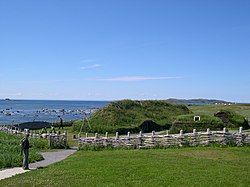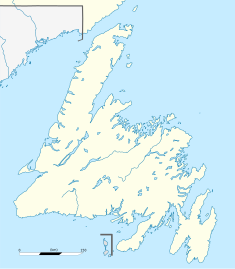| L'Anse aux Meadows | |
|---|---|
 Recreated Norse buildings at L'Anse aux Meadows | |
| Coordinates | 51°35′47″N 55°32′00″W / 51.59639°N 55.53333°W |
| Website | L'Anse aux Meadows National Historic Site |
| Official name | L'Anse aux Meadows National Historic Site |
| Type | Cultural |
| Criteria | vi |
| Designated | 1978 (2nd session) |
| Reference no. | 4 |
| Country | Canada |
| Region | Europe and North America |
| Official name | L'Anse aux Meadows National Historical Site of Canada. |
| Designated | 28 November 1968 |
Location of L'Anse aux Meadows in Newfoundland | |
L'Anse aux Meadows (lit. 'Meadows Cove') is an archaeological site, first excavated in the 1960s, of a Norse settlement dating to approximately 1,000 years ago. The site is located on the northernmost tip of the island of Newfoundland in the Canadian province of Newfoundland and Labrador near St. Anthony.
With carbon dating estimates between 990 – 1050 CE (mean date 1014)[1][2][3] and tree-ring dating of 1021,[4][5][2] L'Anse aux Meadows is the only undisputed site of pre-Columbian trans-oceanic contact of Europeans with the Americas outside of Greenland.[3] It is notable as evidence of the Norse presence in North America and for its possible connection with the accounts of Leif Erikson in the Saga of the Greenlanders and the Saga of Erik the Red,[6] which were written down in the 13th century.[3] Archaeological evidence suggests the settlement served as a base camp for Norse exploration of North America, including regions to the south.[7]
Spanning 8,000 hectares (31 sq mi) of land and sea, the site contains the remains of eight buildings constructed of sod over a wood frame, with over 800 Norse objects unearthed,[8] including bronze, bone, and stone artifacts, and evidence of iron production.[9] The site was designated a National Historic Site of Canada in 1968 and a World Heritage Site by UNESCO in 1978,[10] and is managed by Parks Canada.[11]
- ^ Nydal, Reidar (1989). "A Critical Review of Radiocarbon Dating of a Norse Settlement at L'Anse Aux Meadows, Newfoundland Canada". Radiocarbon. 31 (3): 976–985. Bibcode:1989Radcb..31..976N. doi:10.1017/S0033822200012613. eISSN 1945-5755. ISSN 0033-8222. Archived from the original on 22 November 2021. Retrieved 22 November 2021.
With an assumed total systematic error of 30 ± 20 years, as a mean for various tree rings, the calibrated age range of L'Anse aux Meadows is AD 975–1020. This agrees well with the assumed historical age of ca AD 1000, a result which has also been recently corroborated by high-precision accelerator dating at the University of Toronto.
- ^ a b Cordell, Linda S.; Lightfoot, Kent; McManamon, Francis; Milner, George (2009). "L'Anse aux Meadows National Historic Site". Archaeology in America: An Encyclopedia. ABC-CLIO. p. 82. ISBN 978-0-313-02189-3. Archived from the original on 25 April 2023. Retrieved 22 September 2016.
This is a substantial base for analysis , which yields an entirely credible range of dates between 990 and 1050 and a mean date of 1014 CE , which is popularly rounded off at 1000 CE .
- ^ a b c Ledger, Paul M.; Girdland-Flink, Linus; Forbes, Véronique (15 July 2019). "New horizons at L'Anse aux Meadows". Proceedings of the National Academy of Sciences. 116 (31): 15341–15343. Bibcode:2019PNAS..11615341L. doi:10.1073/PNAS.1907986116. eISSN 1091-6490. ISSN 0027-8424. PMC 6681721. PMID 31308231.
Modeling results were remarkably consistent, and model A suggests Norse occupation began Cal AD 910–1030..... A weighted mean of twig dates—notwithstanding issues associated with combination of 14C ages from multiple individuals—provided a result of AD 986–1022
- ^ Andrei, Mihai (11 September 2023). "Vikings did reach North America a thousand years ago -- and now we know exactly when". ZME Science.
- ^ Kuitems, Margot; Wallace, Birgitta L.; Lindsay, Charles; Scifo, Andrea; Doeve, Petra; Jenkins, Kevin; Lindauer, Susanne; Erdil, Pınar; Ledger, Paul M.; Forbes, Véronique; Vermeeren, Caroline (20 October 2021). "Evidence for European presence in the Americas in AD 1021". Nature. 601 (7893): 388–391. Bibcode:2022Natur.601..388K. doi:10.1038/s41586-021-03972-8. ISSN 1476-4687. PMC 8770119. PMID 34671168. S2CID 239051036.
Our result of AD 1021 for the cutting year constitutes the only secure calendar date for the presence of Europeans across the Atlantic before the voyages of Columbus. Moreover, the fact that our results, on three different trees, converge on the same year is notable and unexpected. This coincidence strongly suggests Norse activity at L'Anse aux Meadows in AD 1021. In addition, our research demonstrates the potential of the AD 993 anomaly in atmospheric 14C concentrations for pinpointing the ages of past migrations and cultural interactions.
- ^ Wallace, Birgitta (2009). "L'Anse aux Meadows, Leif Eriksson's Home in Vinland". Journal of the North Atlantic: 115. ISSN 1935-1984. JSTOR 26686942. Archived from the original on 27 May 2022. Retrieved 27 May 2022.
- ^ Kuitems, Margot; Wallace, Birgitta L.; Lindsay, Charles; Scifo, Andrea; Doeve, Petra; Jenkins, Kevin; Lindauer, Susanne; Erdil, Pınar; Ledger, Paul M.; Forbes, Véronique; Vermeeren, Caroline; Friedrich, Ronny; Dee, Michael W. (January 2022). "Evidence for European presence in the Americas in ad 1021". Nature. 601 (7893): 388–391. Bibcode:2022Natur.601..388K. doi:10.1038/s41586-021-03972-8. ISSN 1476-4687. PMC 8770119. PMID 34671168.
- ^ Sarolta Anna Takacs; Eric H. Cline (17 July 2015). The Ancient World, Volumes 1–5. Routledge. pp. 272–. ISBN 978-1-317-45839-5. Archived from the original on 25 April 2023. Retrieved 6 July 2022.
- ^ Kirsten Wolf (2004). Daily Life of the Vikings. Greenwood Publishing Group. pp. 139–. ISBN 978-0-313-32269-3. OCLC 253909682.
- ^ "L'Anse aux Meadows National Historic Site". UNESCO World Heritage Center. Archived from the original on 16 June 2006. Retrieved 23 December 2018.
L'Anse aux Meadows is the first and only known site established by Vikings in North America and the earliest evidence of European settlement in the New World. As such, it is a unique milestone in the history of human migration and discovery.
- ^ "ENVIRONMENT". www.ourcommons.ca. Archived from the original on 9 October 2022. Retrieved 29 October 2021.
